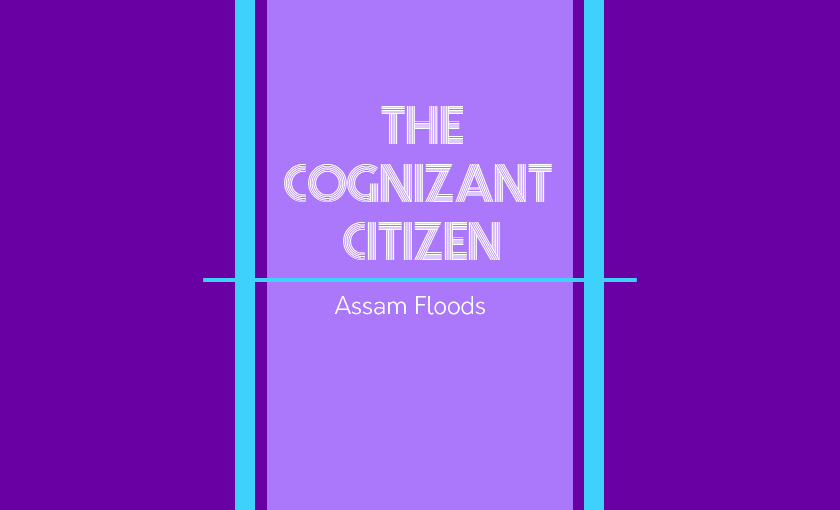
In May 2020, Cyclone Amphan hit parts of Eastern India and Bangladesh. With the unrest caused by the cyclone, several parts of the country received massive amounts of rainfall. This marked the beginning of the Assam floods. An alarming increase in water level was observed throughout several districts of the state. By the 27th of May, about 2,70,000 people were affected. Now, three months later, the state continues to tackle the disaster when a second wave hit on the 20th of June, causing catastrophic aftermath.
An Annual Phenomenon
The Brahmaputra River, along with its many tributaries, forms an extensive network. For a long time, this network replenished the soil and was welcomed by the people. However, these views have changed in recent times.
10.2% of India’s total area is flood-prone, 32.9% of which is in Assam. This is four times the national mark.
The melting glaciers in the summer and the monsoon rains contribute heavily to the rising water levels. The natural riverbanks have been eroded, leading to an overflow of water in low-lying areas.
Another critical factor is that the embankments were built along the river in the 1950s. Unplanned construction and poor environmental assessment have caused the river to change its course. “Embankments confined rivers and cause them to rise higher and flow faster,” as quoted by Charles Ellet, stands true as the floods have only become much worse after this.
Increases in population have resulted in the increase of township without any precautions or intelligent planning. With the decline of the natural banks, more people have moved closer to the river, making them immediate victims of the floods.
What is the cost?
16.5 lakh people across more than half the districts of Assam have been affected, and 107 deaths have been recorded as of the 29th of July. Adding to this are the 26 deaths from the first floods and landslide in early May. 37,000 people have been sheltered across 208 relief camps and 93,000 hectares of crop area have been rendered useless.
The Kaziranga and the Manas National Parks have gotten flooded, causing animals to flee and take shelter in human habitats and high lands. Over 66 animals have fallen prey to the floods, and 170 have been rescued.
Without adequate funds from both the Central Government and the NITI Aayog over the years, the process of construction of essential infrastructure has significantly slowed down, leading to a state of misery. Errors in calculation and accounting have been a major reason for the insufficient funds from the centre since 2014.
Due to the need for social distancing following the Coronavirus pandemic, the Assam Disaster Management Authority has been forced to reduce the maximum capacity of the relief camps. However, this has not stopped shelters from being overcrowded.
Ray of Hope
On 24th of July, President Ram Nath Kovind expressed his solidarity for the people of Assam. Nine trucks were sent to flood-affected districts, carrying Red Cross relief supplies from the Rashtrapati Bhawan.
The Indian Army provided medical aid by setting up camps in Barpeta, one of the worst-hit districts in the state. A 16 member team of National Disaster Response Force (NDRF) evacuated villagers, livestock and transported them from Dighirpam Bazaar in Barpeta to safer areas.
The havoc wreaked by the floods put the lives of even the most protected animals through the wringer. In Majauli, locals left banana trunks and jackfruit on the banks of the river for elephants stranded due to the floods, showing how compassion can survive even in the direst times.
Fortunately, as the floodwaters are seen to be waning recently, the state government of Assam is already on their toes. Demolished embankments are being mended, and people are being provided with land for resettlement. A project of dredging the Brahmaputra river will commence by early next year with dredgers being imported from the US.
Amendments for the Future
Assam floods, being a natural phenomenon, are beyond our control, but we can still prevent it from becoming as treacherous as it got this year. It is easier said than being done, but we need to make efforts on our own part to make our home states safer. This can be achieved by:
1. SPONGE CITIES
It is a rainwater-harvesting technique that uses porous asphalts to make roads. These are then connected to a system that manages the inflow of water, replenishing groundwater levels.
2. FLOOD PLAINS
Removal of urban structures and encroachments is essential to cure Assam’s vulnerability to flooding. Trees and plants guard against the riverbank erosion. Vetiver is a fast-growing grass deemed to be most suitable in these terrains.
3. FLOOD FORECASTING
A more efficient and well-assisted disaster management system would help in faster dissipation of information and rehabilitation of people and animals.
Our Role
With Assam drowning in physical injuries and mental trauma, the onus falls on the rest of the nation to come to the rescue.
Visit the following donation sites to carry out your role in rebuilding the beautiful Assam:
https://www.akshayapatra.org/donate-to-guwahati-flood-relief
https://www.rapidresponse.org.in/assam-floods.html
https://www.donatekart.com/Rapid/assam-floods
Sources:
Hindustan Times, NDTV, Times Now, Economic Times, Diplomat, Scroll, Floodlist, Quint India, Abhi and Niyu (YouTube channel), Times of India
Written by Archana S and Shranya Shrivastava for MTTN
Edited by Cynthia Maria Dsouza for MTTN
Featured Image by Saniya Gupta for MTTN
Leave a Reply
You must be logged in to post a comment.